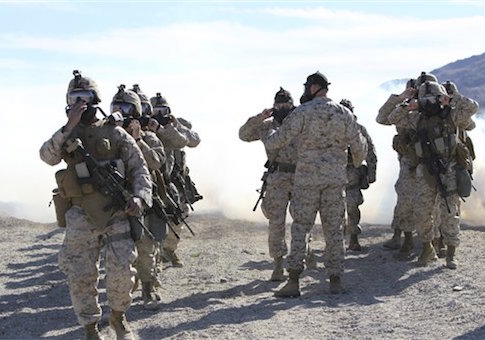The Marine Corps plans to use a troop level increase approved by Congress this week to strengthen its cyber and information operations capabilities.
The Senate on Thursday approved in a 92-7 vote a sweeping defense policy bill that increases the end strength of the active U.S. armed forces, delivering the bill to President Obama's desk for him to sign.
The Marine Corps will receive 3,000 additional active-duty troops from the current baseline of 182,000 Marines with the passage of the fiscal 2017 National Defense Authorization Act. Gen. Robert Neller, the Marine commandant, said Wednesday that the service will use the troop increase to add roles to cyber, information operations, intelligence analysis, and electronic warfare capabilities.
"If we do get an end-strength increase and it's sustainable and we get the money to recruit, train, and equip those Marines, they'll be performing tasks and providing capabilities that we don't think are existing in the current force either in sufficient quantity or they don't exist at all," Neller told an audience at the U.S. Naval Institute's annual defense forum in Washington, D.C., when asked about the anticipated increase.
"What capabilities? Information operations, intelligence analysis and targeting, electronic warfare, cyber," Neller said, adding that the Marines will also add "mundane" jobs in maintenance and communications as well as air defense, engineering, mobility, and counter-mobility.
The Marine commandant has previously highlighted the need to evolve the force and its training to prepare for warfighting in new domains against adversaries with new capabilities. The service is currently developing its "Force 2025" strategy to adapt for modern combat.
Neller said he would have eliminated Marines from certain roles to bolster cyber, information, and other insufficiently staffed capabilities if the service did not receive a boost in end-strength.
"Quite frankly, even if we didn't get the end-strength increase, we were going to create those capabilities and if we had to take Marines from doing 'Job A' right now and put them in these other capability sets, we were going to do that and accept the risk," Neller said. "That makes the decision a lot easier if this all comes to pass."
Lawmakers cheered the 2017 NDAA for halting the drawdown of U.S. military forces. The bill provides for 185,000 Marines in the Marine Corps as well as 476,000 soldiers in the Army, 323,900 sailors in the Navy, and 321,000 airmen in the Air Force.
"If you've got a little thing you want to put in my Christmas stocking that says 185,000 Marine Corps, I'm going to be very happy," Neller said.
The $619 billion defense policy bill also gives U.S. service members a 2.1 percent pay raise and implements a series of reforms to the Defense Department.
Both chambers of Congress approved the legislation with veto-proof majorities and strong bipartisan support.
"The NDAA delivers bold reforms on defense acquisition, military health care, military justice, and security cooperation," said Sen. John McCain (R., Ariz.), chair of the Senate Armed Services Committee, following the bill's passage on Thursday.
"And we achieved these reforms while upholding our commitments to our troops by providing the largest military pay raise since 2010, boosting funds to address the military readiness crisis, and stemming the dangerous drawdown of the Army and Marine Corps. Reform is not easy, but this NDAA shows it is possible," McCain said.
Neller, a career infantry Marine, assumed command of the Marine Corps from Gen. Joseph Dunford, now chair of the Joint Chiefs of Staff, in September 2015. In January, he issued a fragmentary order calling for the development of a "clear-eyed vision" of what the Marine Corps will look like in future years.
"We must continue to be ready for operations across the range of military operations," Neller wrote in January. "At the same time, we recognize the current and future fight may not be what we experienced in the past. It will encompass not just the domains of land, air and sea, but also space and the cyber domain. It will include information operations and operations across the electromagnetic spectrum. It will involve rapidly changing and evolving technologies and concepts, which will force us to be more agile, flexible and adaptable."
